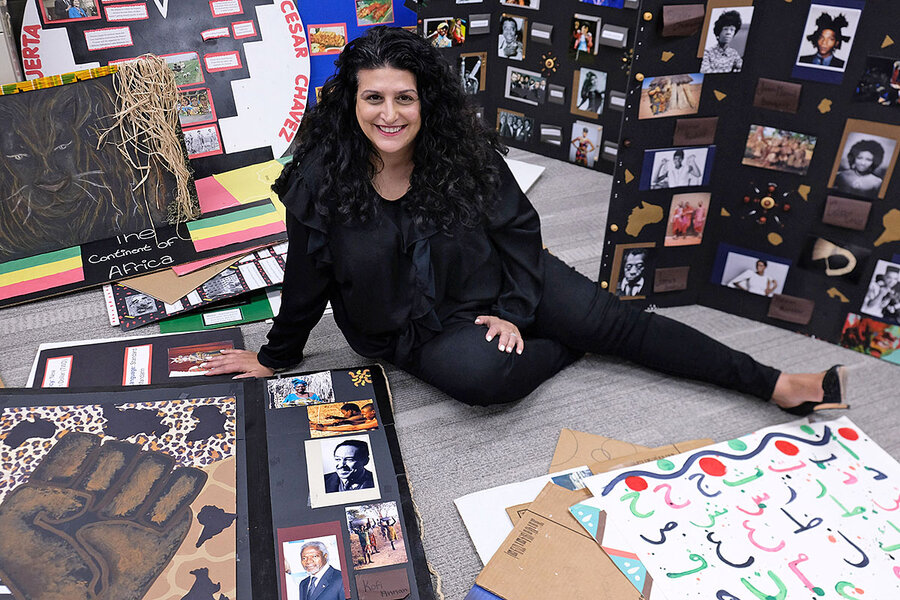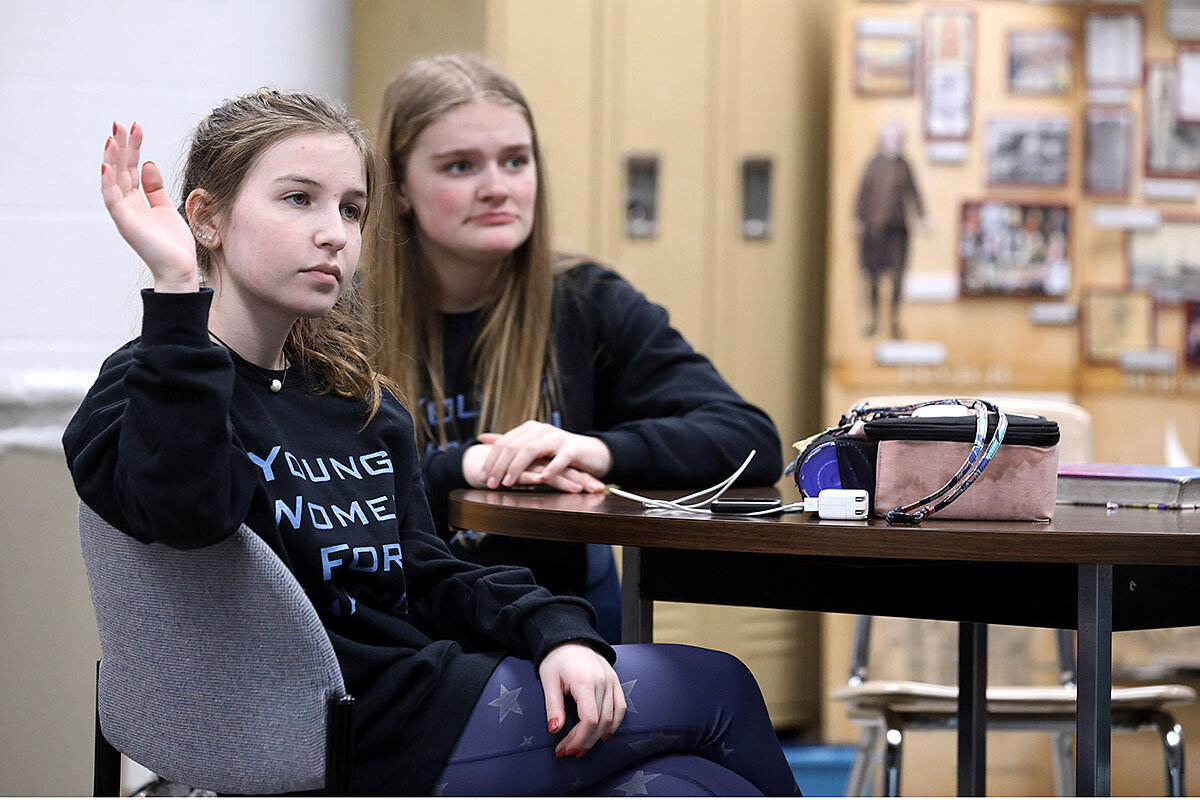How one teacher equips students to stop trafficking before it starts
Loading...
| TOLEDO, Ohio
Ohio ranks fifth in the United States for human trafficking. But Celia Williamson considers that a victory of sorts, because it means that residents have a high degree of awareness of the problem.
“It’s not really about snatching and grabbing people off the street,” says Dr. Williamson, at the University of Toledo. “That is doing a disservice to the reality of trafficking and it has everybody looking in the wrong places.”
Why We Wrote This
Teachers often take their responsibilities beyond the subjects they’re expected to teach. In Ohio, Mona Al-Hayani developed a curriculum for human trafficking that raises awareness among adults and vulnerable young people.
“It’s about vulnerability … That’s the common denominator about trafficked youth,” says Mona Al-Hayani, a history teacher who last year won Ohio’s Teacher of the Year award for stepping up to design a curriculum and train more than 20,000 students and educators about human trafficking.
At the Ohio state capitol last year, Ms. Al-Hayani’s students performed a skit demonstrating how predators lure vulnerable young people. In Toledo almost 20,000 of the district’s 23,000 students are economically disadvantaged, and its public schools have the most homeless students in the state.
“If we don’t arm students with knowledge and power – that when they take informed action change can happen – we’re doomed as a society,” Ms. Al-Hayani says. Teachers act as both “warriors and advocates” in their classrooms every day, she adds. “People don’t really realize that.”
When teacher Mona Al-Hayani looks at high school students, she sees possibilities. But after years of social justice work, she’s also keenly aware of unseen dangers to young people.
So when the state of Ohio mandated five years ago that public school staff receive training on human trafficking – without providing any money or much direction – “Ms. Al,” as she’s called, stepped up.
She developed a curriculum for the Toledo district, trained more than 20,000 students and educators in how to identify risk factors, connected the schools to local advocacy groups, and has started offering training for nearby communities. The effort earned her Ohio’s Teacher of the Year award in 2019, and the admiration of advocates for impoverished young people who are most at risk.
Why We Wrote This
Teachers often take their responsibilities beyond the subjects they’re expected to teach. In Ohio, Mona Al-Hayani developed a curriculum for human trafficking that raises awareness among adults and vulnerable young people.
As her school prepares to start the year remotely, Ms. Al-Hayani has been helping develop an app called Youth Pages, which offers resources to mitigate factors that lead to human trafficking.
Sandy Sieben, co-chair of the Lucas County Human Trafficking Coalition (LCHTC), has a simple answer for those who ask how Toledo has managed to come this far: “We say, ‘Mona.’ It’s because of Mona’s respect in the community and her ability. Mona’s really talented and skilled in talking to all levels.”
Traffickers prey on victims’ vulnerabilities, and high school students can be easy targets. A 2019 report by the University of Cincinnati School of Criminal Justice said most victims trafficked that year were between 12 and 30 years old, with about 86% identified as minors. Most cases involve teenagers in abusive relationships who are tricked into sex trafficking by their partner.
Anti-trafficking advocates are also fighting a newer phenomenon, the conspiracy theories perpetuated on social media that attempt to link high-profile people to trafficking.
“They’re giving you the caricature of a sensationalized sliver of what might be happening,” says Celia Williamson, director of the Human Trafficking and Social Justice Institute at the University of Toledo and founder of the LCHTC.
False stories often focus on a specific prominent person or organization that is supposedly trafficking. But that misinformation discounts the factors that contribute to the problem, she adds. Instead, it panics the public and leads to “institutionalized privilege” – with individuals investing money to help communities that are already protected. “What we’re trying to address is the more common manipulation that occurs,” says. Dr. Williamson.
“It’s not really about snatching and grabbing people off the street. That is doing a disservice to the reality of trafficking and it has everybody looking in the wrong places.”
Vulnerabilities preyed on
Toledo and Lucas County have a large proportion of vulnerable young people. Ohio Department of Education data indicates that Toledo public schools had more homeless students, about 2,700, than any other district in the state during the 2015-2016 year. Almost 20,000 of the district’s 23,000 students are economically disadvantaged. Those challenges could worsen in a recession caused by the coronavirus pandemic.
Dr. Williamson considers it a victory of sorts that Ohio placed fifth on a list compiled by the Polaris Project of states with human trafficking problems. The list is based on calls to a hotline, so Ohio’s ranking reflects a high degree of awareness, she says. By focusing on the demographic most at risk, Toledo is able to identify individuals being exploited that other cities do not.
“It’s about vulnerability ... That’s the common denominator about trafficked youth,” says Ms. Al-Hayani, whose program includes educating students and teachers on how to resist and detect trafficking.
Ms. Al-Hayani says her passion for community education began as she watched her mother lead discussions about Islam during a time when Americans had little concept of it. Her mother, Fatima, taught French and English while completing her doctorate in Islamic jurisprudence.
“My mom always spoke the truth,” Ms. Al-Hayani says. “Even if she knew that it would alienate people. She always was political, in the sense where she used education as a tool to teach people about the right path, and I took all of that from her.”
Dr. Al-Hayani gave a university talk about Islam two days after 9/11, though friends and family worried for her safety and pleaded with her to cancel it. Through her work on a peace and justice committee, she has held anti-human trafficking workshops for social workers, teachers, and detectives, and she worked on state legislation to stop the criminalization of victims of sex trafficking.
“Mona and her mom were advocates for the victims of human trafficking even before it was popular,” their family friend, Cherrefe Kadri explains. “So when that movement was first getting started, they were at the forefront.”
A self-described “Toledo girl,” Mona Al-Hayani studied sociology at the University of Toledo. The first Gulf War was raging when she was a freshman, and she recalls a group of young men who shouted “Go back where you came from” as she was returning to her car after attending a lecture.
“I remember that moment really was a defining point for me,” Ms. Al-Hayani says.
Her father’s country, Iraq, was at war with America. She protested the sanctions against Iraq, because of how children were negatively affected by them.
Watching her father get pulled aside for extra airport screening, or adjusting to FBI monitoring of their house because her father was a supervisor of a municipal water plant, made her reflect on her identity, Ms. Al-Hayani says.
“All of those things shaped me to look at social justice through a different lens,” she says. She got a chance to act on her values when she set foot in Woodward High School in Toledo as a substitute teacher in 1999.
The school had a reputation for a high suspension rate. Her students included seniors who had failed ninth grade reading tests. Many were unsure if they would graduate.
“My goal the first year was to make sure that they graduated, and they did,” Ms. Al-Hayani says. So she remained a high school teacher, moving later to Toledo Early College High School.
Thirteen years ago, she created an international festival for one of the most diverse schools in the state, focused on the food and culture of different countries. The idea came after a student of Mexican heritage approached her about arranging a Cinco de Mayo celebration.
“I’ve never seen anything like this in the system,” says Victoria Smith, a Toledo Public Schools Spanish teacher, who’s taught for about 25 years. “It makes my job easier because the kids, they get fired up about the I-Fest. They do look forward to it all year long.”
The event is organized by Young Women for Change, a group at school that Ms. Al-Hayani started. Other students create displays full of historical facts about each country.
I-Fest has changed their perception of the world, says Jada McIntyre, a team captain for the event. “You could be in social studies class all day,” she adds. “You can retain that information, but when you get that visual, when you get to just help in the project, see it come together, you know, taste the food, see the performances, see all the boards and artifacts, it makes it feel more real and it’s easier to connect with it.”
Empowering young women
In addition to being Ohio’s Teacher of the Year in 2019, Ms. Al-Hayani is this year’s teacher fellow for the Ohio Department of Education and the recipient of a YWCA award that honors women in northwest Ohio for their work in empowering other women. Lisa McDuffie, president and CEO of the YWCA, says Ms. Al-Hayani’s contribution was so significant that she could have won in several other categories, as well.
Dr. Williamson says that Ms. Al-Hayani’s role as an educator was a game changer for the anti-trafficking coalition, allowing it to progress from education and awareness to prevention. By collaborating with the LCHTC and the University of Toledo, Ms. Al-Hayani has reached out to students in cities like Tiffin and Sandusky. Through the LCHTC, representatives of 36 agencies from five counties meet monthly to discuss prevention, intervention, and programming.
During a gathering at the Ohio state capitol last year, Ms. Al-Hayani’s students performed a skit demonstrating how predators use coercion, force, and fraud to lure vulnerable young people.
“If we don’t arm students with knowledge and power – that when they take informed action change can happen, we’re doomed as a society,” Ms. Al-Hayani says. Teachers act as both “warriors and advocates” in their classrooms every day. “People don’t really realize that.”
This story was produced in association with the Round Earth Media program of the International Women’s Media Foundation.








